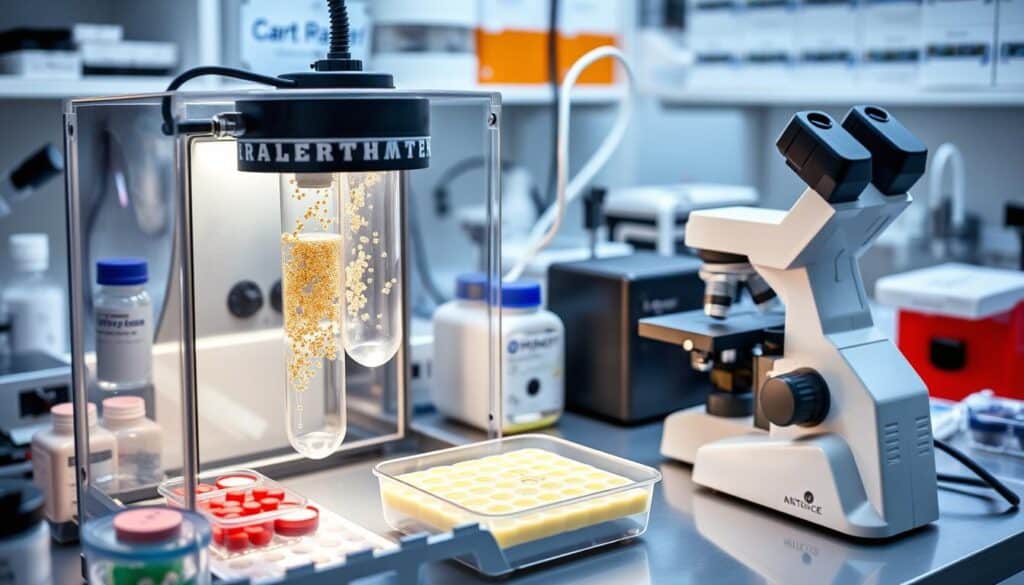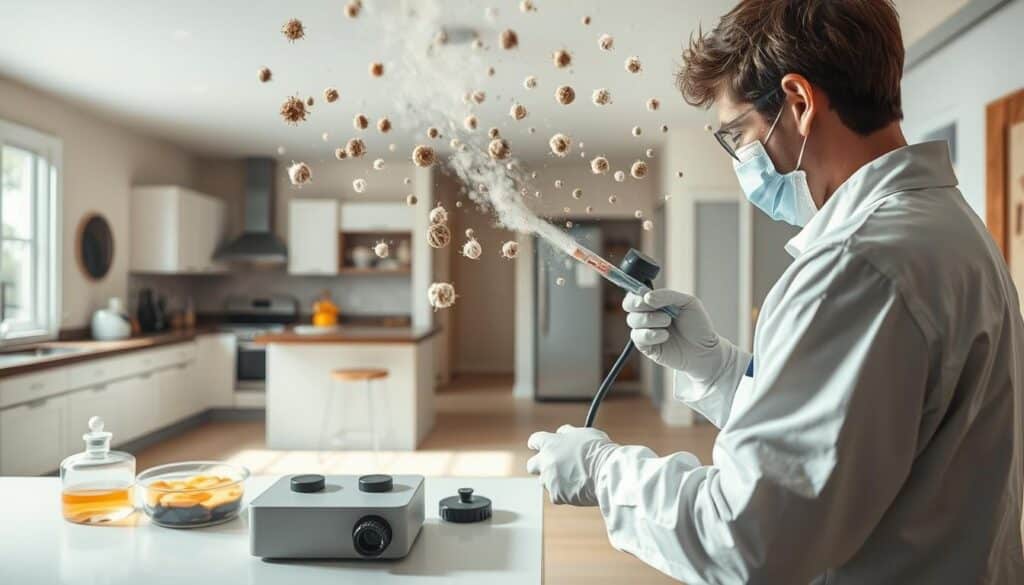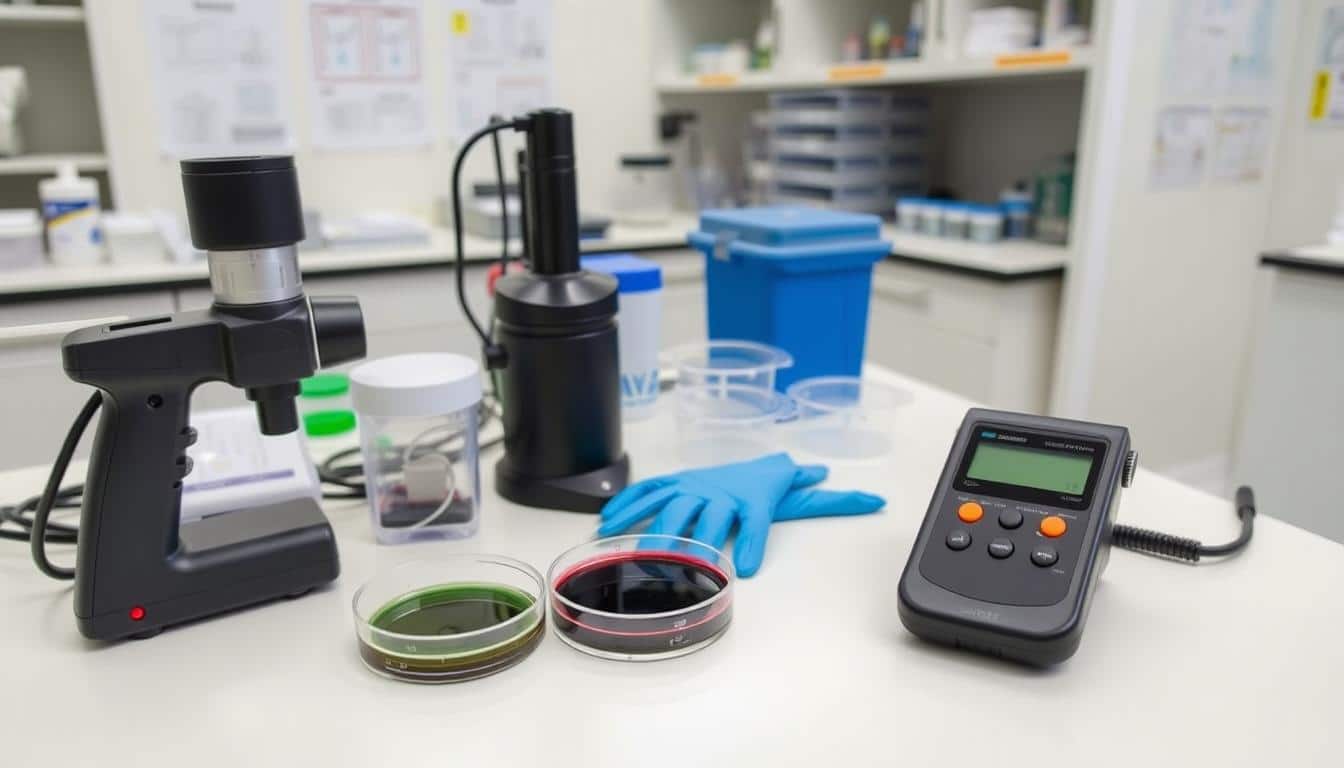Did you know we spend 90% of our time indoors? This fact shows how vital indoor air quality is. As an environmental microbiologist, I’ve seen how mould air sampling reveals hidden air quality problems that affect our daily lives.
Mould air sampling is a key tool for checking indoor air quality. It involves taking air samples to find and count fungal spores in our homes. This is important for comparing indoor and outdoor spore levels. It helps us find health risks and if we need to clean the air.
In my work, air sampling devices like impaction samplers and cassette samplers are very useful. They force air through a sampler, catching spores on a growth medium or in a special container for testing.
The Environmental Protection Agency (EPA) says an indoor mould spore count under 500 spores per cubic meter is normal. But, if it’s over this, we need to look closer. Some mould, like Stachybotrys chartarum, can be harmful even at low levels, especially for people with allergies or breathing problems.
Key Takeaways
- Mould air sampling is essential for detecting indoor air quality issues
- Air sampling typically takes 1-10 minutes to assess airborne mould spores
- EPA considers under 500 spores/m³ as normal indoor mould levels
- Various sampling methods exist, including impaction, cassette, and qPCR
- Air sampling results help compare indoor and outdoor spore levels
- Proper sampling is crucial for accurate mould detection and remediation planning
Understanding Indoor Air Quality and Its Importance
Indoor air quality is key to our daily lives. We spend about 90% of our time indoors. This makes it crucial to know how indoor air affects our health. Testing indoor air quality has become more important in recent years.
The impact of indoor air quality on health
Poor indoor air quality can cause serious health problems. The World Health Organization says 3.8 million people die each year from indoor air pollution. In the U.S., radon causes about 21,000 lung cancer deaths yearly.
Common sources of indoor air pollution
Many things can pollute indoor air. These include outdoor air, spores from people and pets, and fungi from too much moisture. Radon, formaldehyde, and other contaminants also affect indoor air quality.
Why mould is a significant concern
Mould is a big indoor air quality problem. Assessing fungal contamination is key to spotting health risks. Some moulds, like Aspergillus fumigatus, can cause lung infections in those with weak immune systems. High levels of Penicillium have been linked to asthma in kids.
| Mould Type | Potential Health Effects | Common Indoor Sources |
|---|---|---|
| Stachybotrys chartarum (Black Mold) | Produces mycotoxin satratoxin, linked to toxic effects | High humidity areas |
| Aspergillus fumigatus | Lung infections in immunocompromised individuals | Damp building materials |
| Penicillium | Associated with childhood asthma | Food, carpets, wallpaper |
Knowing about indoor air quality is essential for a healthy home or workplace. Good occupational hygiene practices help find and fix air quality problems.
The Basics of Mould Air Sampling
Mold air sampling is key to checking our indoor air. It collects air samples to find out what mold spores are in our homes.
Special tools like impaction samplers and airborne-particle collectors are used. They push air through a medium, catching spores for later study.

Protocols for air monitoring include taking samples inside and outside. This helps figure out if indoor mold is too high.
| Location | Common Mold Types | Peak Season |
|---|---|---|
| Indoor | Penicillium, Aspergillus | Year-round |
| Outdoor | Cladosporium, Alternaria | August – October |
Mold spore analysis results are shown in CFU/m³. This tells us about harmful mold and if we need to clean it up.
Checking HVAC systems is also part of mold checks. These systems can spread mold spores, making them important to inspect.
Remember, mold air sampling is just one part of the solution. Adding visual checks and moisture tests gives a fuller view of air quality problems.
Types of Mould Air Sampling Methods
In my work with environmental microbiology, I’ve learned that knowing about mould air sampling methods is key. It helps us assess fungal contamination effectively. Let’s look at the main types used for airborne particulate sampling.
Impaction Samplers
Impaction samplers are my first choice for fast results. They use a calibrated air pump to catch spores on a microscope slide. They’re excellent for quickly measuring mould spore levels in the air.
Cassette Samplers
Cassette samplers are versatile. They come in disposable or reusable forms and use forced air to trap spores on collection media. They’re great for both sampling on-site and in the lab.
Airborne-particle Collectors
For detailed species identification, I rely on airborne-particle collectors. They trap spores directly on culture dishes, allowing for precise mould species identification. This method is crucial for thorough indoor air quality assessments.
| Sampling Method | Best For | Analysis Type |
|---|---|---|
| Impaction Samplers | Quick spore counts | Microscopic examination |
| Cassette Samplers | Versatile sampling | Lab analysis |
| Airborne-particle Collectors | Species identification | Culture and microscopic analysis |
Each method gives us unique insights into indoor air quality and potential mould issues. By using these techniques together, I can give a full picture of mould in any environment.
When to Conduct Mould Air Sampling
Many people wonder when to do mould air sampling. This step is key in finding hidden problems that affect the air inside. Let’s look at when it’s best to do this test.
Visual Signs of Mould Growth
Seeing visible mould is a clear sign to do mould air sampling. Even small spots can mean a big problem. If you notice color changes on walls or ceilings, it’s time to check closer.
Musty Odors and Moisture Issues
Mould can hide in walls or under floors. If you smell a musty smell or see damp spots, it’s a good idea to test. Mould air sampling can find spores, even if you can’t see them.

After Water Damage or Flooding
Water damage or flooding raises the risk of mould. Professional mold testing is recommended after such events. Quick action can stop big damage and health problems.
| Sampling Method | Result Format | Turnaround Time |
|---|---|---|
| Direct Examination Air Sampling | Spores per cubic meter (spores/m3) | 24 to 72 hours |
| Culturable Air Sampling | Colony forming units per cubic meter (CFU/m3) | 7 to 14 days |
Remember, testing indoor air quality is more than just looking for mould. It’s a way to keep your home healthy. Knowing when to do mould air sampling helps protect your home and health.
The Mould Air Sampling Process
Mold air sampling is key to finding indoor air quality problems. It needs careful planning and execution for accurate results. Understanding mold in our homes is crucial, thanks to environmental microbiology.
When I do mold spore analysis, I stick to certain air monitoring steps. These include:
- Positioning the sampling device 3 to 6 feet off the ground
- Sampling for 10 minutes in clean environments, 5 minutes in high-activity areas
- Maintaining closed conditions during sampling
- Collecting both indoor and outdoor samples for comparison
The Air-O-Cell cassette is a common tool for sampling. It needs a flow rate of 15 liters per minute for best results. I always calibrate the sampler pump to this before starting.
Weather can affect sampling results. I avoid sampling during severe storms or high winds. For quality control, I send blank cassettes for analysis and compare indoor samples with outdoor ones.
Mold spores are too small to see with the naked eye. Air sampling is vital for finding them. This process helps identify specific mold species, making it easier to fix the problem. Even without visible signs, professional air quality tests can find hidden mold, proving what’s really there.
By following these steps, I get accurate mold air sampling results. This helps in assessing and fixing indoor air quality effectively.
Interpreting Mould Air Sampling Results
Understanding mold air sampling results is key for effective fungal contamination assessment. It’s a crucial part of indoor air quality testing. It helps identify potential health risks and guides remediation efforts.
Understanding Spore Counts
Mold spore analysis reports concentrations in colony-forming units per cubic meter (CFU/m³). In my experience, indoor spore levels below 500 CFU/m³ are generally normal. Higher counts might indicate a mold problem that needs attention.
Comparing Indoor and Outdoor Levels
A critical aspect of interpreting results is comparing indoor and outdoor levels. Indoor concentrations should typically be lower than outdoor ones. If they’re not, it could signal an indoor mold issue. Professional mold testing often involves taking samples from various areas inside and outside the home for a comprehensive assessment.
| Location | Normal Spore Count (CFU/m³) | Concerning Spore Count (CFU/m³) |
|---|---|---|
| Indoor | 0-500 | >1,500 |
| Outdoor | 500-1,500 | >2,500 |
Identifying Potentially Harmful Mould Species
Different mold species can have varying health impacts. Common indoor molds like Penicillium, Cladosporium, and Aspergillus are often found in air samples. However, species like Stachybotrys chartarum (black mold) can be particularly concerning due to their potential to produce mycotoxins.
Even low concentrations of mold spores can trigger health issues in sensitive individuals. That’s why professional interpretation of mold air sampling results is essential. It’s important for accurate fungal contamination assessment and effective indoor air quality testing.
Benefits and Limitations of Mould Air Sampling
Mould air sampling is key in indoor air quality testing. It helps find invisible mould spores and checks contamination levels. It’s great for spotting mould in hard-to-reach places.
Experts in environmental microbiology use it to find mould problems. It shows if cleaning worked and helps understand a space’s air quality.
But, mould air sampling has its downsides. Results can change based on when and where you sample, and the environment. One sample might not show the whole picture of indoor air quality. It also can’t find where mould started or if it damaged the building.
To really understand mould, I suggest using air sampling with visual checks and other tests. This way, you get a clear picture of the problem. It helps in finding the best ways to fix it.
- Non-viable sampling can quickly count and identify mould spores
- Viable sampling lets you find specific mould species
- Both methods are strong and are often used together for a detailed analysis
Choosing between viable and non-viable sampling depends on what you want to know. For example, hospitals might need both to know the total mould in the air and find specific types.
Mould Air Sampling for Indoor Air Quality Assessment
Mould air sampling is key for indoor air quality testing. It shows us how many mould spores are in the air. Knowing this helps keep our homes healthy and stops mould problems early.
Integration with other air quality tests
Mould air sampling works well with other tests to check air health. I suggest doing it with HVAC system checks. This way, we find mould and other air issues, giving a full view of indoor air.
Role in comprehensive mould inspections
Mould air sampling is important in full mould checks. It finds mould spores in the air that we can’t see. This is great for finding mould that’s hidden, like behind walls.
Importance in remediation planning
The findings from mould air sampling guide how to fix mould problems. It tells us how bad the mould is and what to do. This helps make a plan to fix the mould and make the air safe again.
FAQ
What is mould air sampling?
Mould air sampling collects air to check for mould spores indoors. It finds air quality problems and health risks from mould.
Why is indoor air quality important?
Good indoor air is key to health. Bad air can cause breathing issues and allergies. Since we’re indoors most of the time, clean air is vital.
What are the common sources of indoor air pollution?
Indoor air pollution comes from outside air, spores on people and pets, and fungi from too much moisture. Mould is a big worry because it can cause allergies and health problems.
What are some types of mould air sampling methods?
There are several ways to sample for mould, like impaction samplers and cassette samplers. Each uses special tools to catch and study mould spores in the air.
When should mould air sampling be conducted?
Test for mould when you see it, smell musty odors, or have moisture issues. Also, after water damage or floods. Test in busy areas and near HVAC units to find hidden mould.
How is mould air sampling conducted?
The process involves taking air samples for 5-10 minutes in a room’s center. The device is 3-6 feet off the ground. Samples are taken indoors and outdoors for comparison.
How are mould air sampling results interpreted?
Results show spore counts and compare them to outdoor levels. They identify mould species. High indoor counts and harmful species like Stachybotrys chartarum suggest mould issues.
What are the benefits and limitations of mould air sampling?
It finds hidden mould spores, identifies species, and checks contamination levels. But, it can be affected by environmental factors. It can’t pinpoint mould sources. A full assessment with other methods is needed.
How is mould air sampling used in indoor air quality assessments?
Mould air sampling is part of a bigger air quality check. It works with other tests and inspections to understand indoor air health. It’s key for mould inspections, planning cleanups, and checking if cleanups worked.




